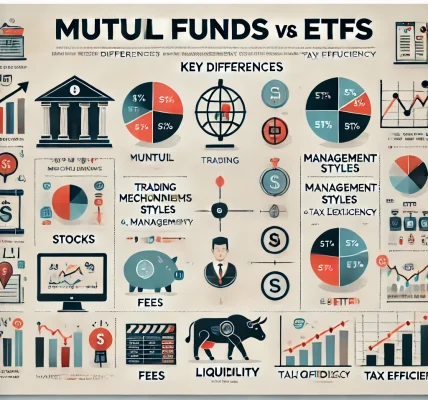Investing in mutual funds is a long-term strategy, but market cycles play a crucial role in determining returns. Smart investors understand how different market phases affect their mutual fund investments and adjust their strategies accordingly.
In this guide, we will break down market cycles, their impact on mutual funds, and how investors can navigate through various market conditions to maximize returns.
1. Understanding Market Cycles
What Are Market Cycles?
A market cycle refers to the fluctuations in financial markets between periods of growth and decline. These cycles can last for months or even years and are influenced by factors like economic growth, inflation, interest rates, and investor sentiment.
A typical market cycle consists of four phases:
- Expansion (Bull Market): Economic growth, rising stock prices, and increased investor confidence.
- Peak: Market reaches its highest point, often followed by economic overheating.
- Contraction (Bear Market): Economic slowdown, declining stock prices, and rising investor fear.
- Trough: Market bottoms out, setting the stage for recovery and a new expansion phase.
2. How Different Market Phases Affect Mutual Fund Investments
A. Expansion Phase (Bull Market)
Impact on Mutual Funds:
- Equity Funds: Perform well as stock prices rise.
- Debt Funds: May experience lower returns due to rising interest rates.
- Hybrid Funds: Balanced funds benefit from both stock and bond market movements.
Investor Strategy:
- Consider growth-oriented funds such as large-cap and mid-cap equity funds.
- Increase allocation to sectoral and thematic funds in booming industries.
- Stay invested to ride the upward momentum.
B. Peak Phase
Impact on Mutual Funds:
- Equity Funds: High valuations may lead to volatility.
- Debt Funds: Interest rates may start rising, reducing bond prices.
- Gold and Commodity Funds: Often rise due to market uncertainty.
Investor Strategy:
- Consider booking partial profits in equity funds.
- Diversify into defensive sectors like FMCG, healthcare, and utilities.
- Increase allocation to balanced or hybrid funds to mitigate risk.
C. Contraction Phase (Bear Market)
Impact on Mutual Funds:
- Equity Funds: Significant losses due to falling stock prices.
- Debt Funds: May provide stability as interest rates drop.
- Gold and Liquid Funds: Become attractive safe-haven investments.
Investor Strategy:
- Avoid panic selling; instead, use Systematic Investment Plans (SIPs) to buy at lower prices.
- Shift towards blue-chip and defensive funds with stable earnings.
- Increase exposure to debt and liquid funds for stability.
D. Trough Phase
Impact on Mutual Funds:
- Equity Funds: Begin recovering as market sentiment improves.
- Debt Funds: Continue stable performance as interest rates remain low.
- Balanced and Hybrid Funds: See renewed investor interest.
Investor Strategy:
- Gradually increase exposure to equity mutual funds as recovery begins.
- Rebalance portfolio to align with long-term investment goals.
- Stay patient and avoid emotional investing.
3. Key Strategies to Navigate Market Cycles
A. Asset Allocation & Diversification
- Maintain a mix of equity, debt, and alternative assets.
- Adjust allocations based on market conditions but avoid extreme shifts.
- Diversification helps reduce risks and optimize returns.
B. Systematic Investment Plan (SIP) Approach
- SIP investing ensures cost averaging, reducing the impact of market volatility.
- Investing regularly avoids timing the market, which is difficult.
- SIPs perform best during bear markets as more units are purchased at lower prices.
C. Rebalancing Portfolio Periodically
- Assess and adjust your portfolio every 6-12 months.
- Reduce equity exposure in prolonged bull markets and increase during downturns.
- Keep investment goals in focus rather than reacting emotionally.
D. Staying Informed & Avoiding Panic
- Monitor economic indicators like GDP growth, inflation, and interest rates.
- Avoid making impulsive decisions based on short-term market noise.
- Focus on long-term financial goals rather than reacting to every market movement.
4. Historical Data: How Mutual Funds Have Performed Across Cycles
| Market Phase | Equity Funds (Avg. Return) | Debt Funds (Avg. Return) | Gold Funds (Avg. Return) |
|---|---|---|---|
| Expansion | 15-20% | 4-6% | 5-8% |
| Peak | 5-10% | 3-5% | 10-15% |
| Contraction | (-10) to (-30)% | 6-8% | 15-25% |
| Trough | 10-15% | 5-7% | 5-10% |
(Source: Historical market trends, past performance does not guarantee future returns.)
5. Final Thoughts: How to Stay Ahead in Market Cycles
- Patience and discipline are key to successful investing.
- Asset allocation and SIPs help mitigate market fluctuations.
- Investing in mutual funds should align with long-term financial goals rather than short-term trends.
- Seek professional financial advice before making major investment decisions.
Conclusion: Market cycles are inevitable, but smart investors can navigate through them effectively by understanding their impact, staying diversified, and making data-driven investment decisions.




